Organic Farming in Japan for Higher Antioxidant
Japan has the highest life expectancy in the world. The average reached record highs for both women and men in 2020. That are 87.74 years and 81.64 years respectively according to the Japanese Ministry of Health. How does high antioxidant foods play a role here?
Studies like this & this and more have shared scientific discovery about the secret of longevity in Japan. The key is to eat organic foods with high antioxidants but it’s not easy to get. They’re more expensive because the cost of growing is higher.
Good news is, farmers in Japan have figured a way to reach that. Less effort, lower cost but high in nutrition and antioxidant foods. In this section, you will learn what might affect the level of antioxidant.

What is Happy Micro?
Happy Micro is an inorganic product made of 100% natural resource such as solidified magma and volcanic ash. It is a magical catalyst to stimulte microorganisms existed in soil and water to naturally transform the environment. Happy Micro is not a checmical nor biotechnology product and it is safe.
National Agriculture Competition

Japan Organic Farming Association has been organizing Nutrition Value Contests to support and educate farmers to grow more nutritious and high antioxidant foods. There are five elements: (1) sugar content, (2) antioxidant, (3) vitamin C, (4) nitrate ion, and (5) taste.
We have farmers who adopted Happy Micro method to grow various vegetables and fruits. You can find various agricultural products undergo this contest once we briefly explain the measurement for those elements.
Nitrite
The higher the value of each element, the better its quality in terms of taste and health except nitrite Ion. The WHO recommended the daily upper limit of nitrate and nitrite uptake to be 3.7 mg/kg and 0.06-0.07 mg/kg, respectively.
Antioxidant
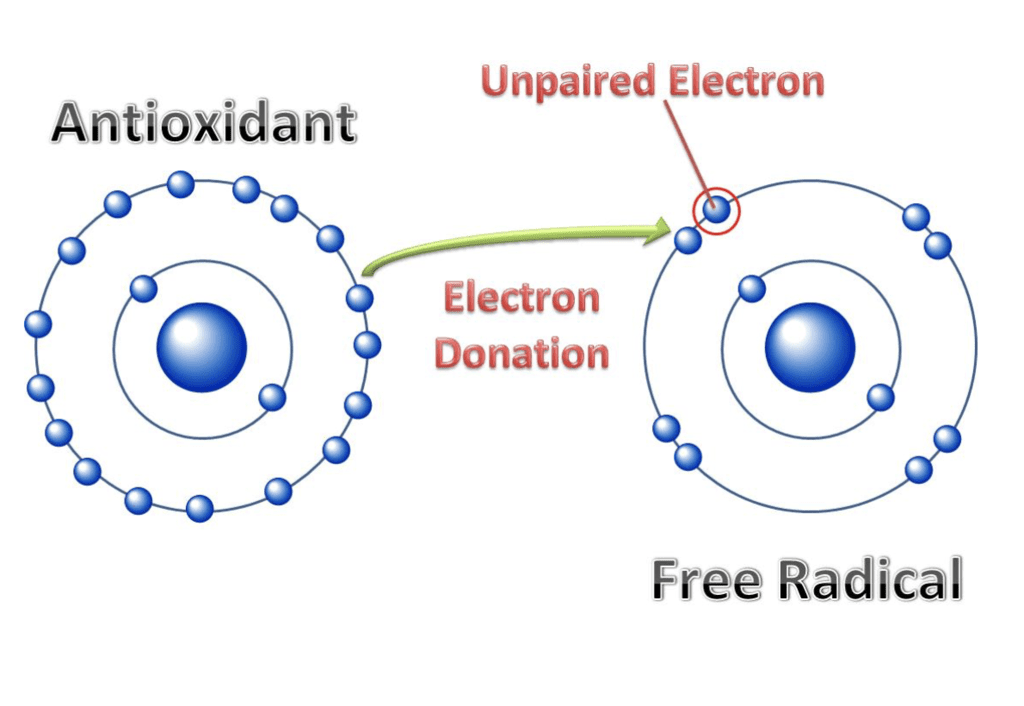
Free radicals are produced during the biological oxidation reaction. Because the radicals are reactive, they start the chain reaction simultaneously. This can lead to the damage or even the death of a cell. Antioxidant is the substrate that prevents the oxidation of molecules inside a cell. It is a well-known chemical process that allows the removal of electrons or hydrogen from a substance. Hence, antioxidant agents are capable of terminating a chain reaction by eliminating free radical intermediates. (Reference)
DPPH
It was developed by Blois MS published on Nature with the viewpoint to determine the antioxidant activity in a like manner by using a stable free radical. The assay is based on the measurement of the scavenging capacity of antioxidants towards it. The odd electron of nitrogen atom in DPPH is reduced by receiving a hydrogen atom from antioxidants to the corresponding hydrazine (Reference). More about this method of determine antioxidant activity.
In general, Happy Micro makes much higher antioxidant up to 6.79 times. The nitrite ion level is also much lower that could go down as low as less than 2% of the national average. We share the comparison for a few agricultural products below so let’s start with a few explanation.
Real World Examples
Charts & Tables
In the laser chart, the green color indicates the value of the sample using Happy Micro and the gray is the national average. The higher, the better elements are Antioxidant and Vitamin C. Higher Sugar is more tasty but not necessarily healthier. Lower Nitrite is better.
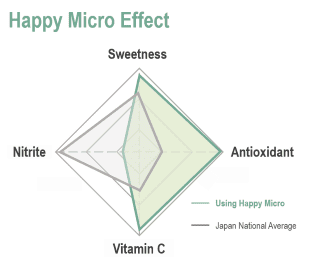
High antioxidant vegetable, using Happy Micro without any fertilizer or chemical
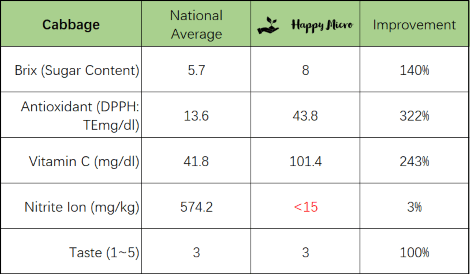
High antioxidant vegetable, using Happy Micro without any fertilizer or chemical
The table shows the measured outcome for each element and the comparison between “National Average” and Happy Micro. “<” for Nitrite Ion means the actual number is lower than the measurable range. (The “Improvement Percentage” is based on the number shown in the table)
Nutrition Value & RDI
The data of National Average is provided by Medical Fruit and Vegetable Research Institute.
Nutrition Fact is based on the data from USDA.
RDI is a Recommended Daily Intake which does not mean 100% of RDI is the best or more than 100% lead to negative health impact. UL is the nutrition upper limit intake so RDI is the target and UL is the limit. UL is usually 7 to 20 times higher than RDI or not limit depends on the nutrient. More details about RDI and UL.

High Antioxidant Cabbage
Results with Happy Micro
Cabbage made with diverse and happy microorganism is higher in sugar content, antioxidant and vitamin C and much lower nitrite.

High antioxidant cabbage comparing with Japan national average and Happy Micro without any fertilizer or chemical

High antioxidant cabbage comparing with Japan national average and Happy Micro without any fertilizer or chemical
The cabbage grown with Happy Micro has 1.4 times more sugar content, 3.2 times higher antioxidant, 2.4 times more vitamin C and less than 3% of nitrite compared with the national average provided by Medical Fruit and Vegetable Research Institute.
This means, you can consume much less cabbage made with Happy Micro to get the nutrition you need. Cabbage made with Happy Micro method becomes a high antioxidant food. The following section describes the nutrition fact of cabbage based on the data from USDA.
Nutrition Fact of Cabbage
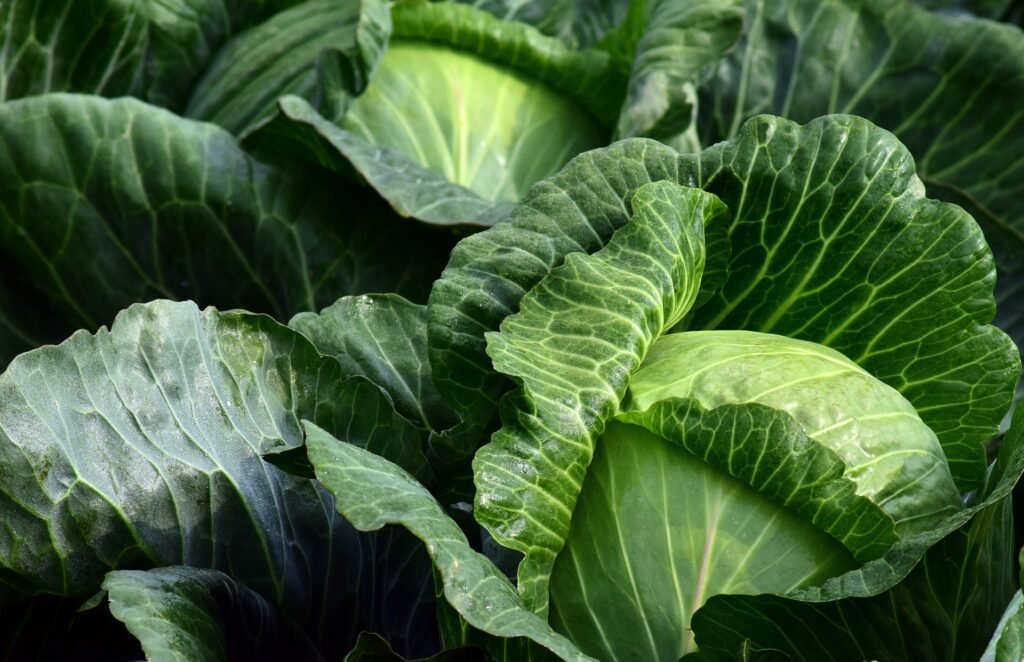
Cabbage is widely consumed vegetable. It is rich in vitamin B6 and folate, both of which are essential for many important processes in the body, including energy metabolism and the normal functioning of the nervous system.
It is also high in antioxidants and high in vitamin C, a potent antioxidant that may protect against heart disease, certain cancers and vision loss (Reference #1, #2, #3).
The typical consumption of cabbage is somewhere between 200g to 300g and it is enough to meet RDI for vitamin C and vitamin K. (Data Source)
High Antioxidant Black Edamame
Results with Happy Micro
Black Edamame made with diverse and happy microorganism is much higher in sugar content, antioxidant and vitamin C with much lower nitrite.
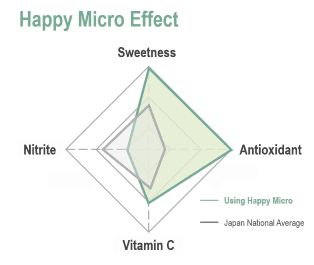
High antioxidant Black Edamame comparing with Japan national average and Happy Micro without any fertilizer or chemical

High antioxidant Black Edamame comparing with Japan national average and Happy Micro without any fertilizer or chemical
The Black Edamame grown with Happy Micro is 1.8 times higher in sugar content, 4.8 times higher antioxidant, 1.1 times more vitamin C and less than 55% of nitrite compared with the national average.
What is crazy about this black edamame is that its sweetness is higher than Japanese melon. If you have ever eaten a Japanese melon, you know how sweet this edamame is. Of course, its nutrient is also higher than the national average. The following section describes the nutrition fact of Edamame (No Black Edamame data is available) based on the data from USDA.
Nutrition Fact of Edamame

Edamame is a low calorie but nutrition dense food. It is also an ideal food for vegan or vegetarian. 100g edamame contains 34% RDI of protein, 121% folate, 79% manganese, 52% vitamin K, 27% copper and so much more benefitial nutrient for our body. (Data Source)
High Antioxidant Spinach
Results with Happy Micro
Spinach made with diverse and happy microorganism is lower in vitamin C and significant lower in nitrite, higher in antioxidant and sugar content.

High antioxidant spinach comparing with Japan national average and Happy Micro without any fertilizer or chemical

High antioxidant spinach comparing with Japan national average and Happy Micro without any fertilizer or chemical
The Spinach grown with Happy Micro is 1.7 times higher in sugar content, 1.6 times higher antioxidant, 0.6 times less vitamin C and the nitrite is less than 2% compared with the national average. Spinach made with Happy Micro method becomes a high antioxidant food and also tasty.
Nutrition Fact of Spinach

Spinach constantly appears in all kinds of cuisine. For vegan or vegetarian, it is known for vitamin A, C, K, folate, calsium, iron, magnesium and manganese. However, as mentioned above, spanich contains high oxalate so a proper amount of intake is critical to our health.
It is particularly interesting vegetable for us to dive deep because it contains high amount of oxalate which binds to minerals like calcium to prevent our body from absorbing beneficial nutrients in the digestive tract. Also, consuming too much oxalate increases risk of kidney stones.
We have not yet discovered the correlation between nitrite and oxalate but the “Taste” participants could taste the sweetness instead of “grassy” and the aftertaste was not chalky or gritty feeling. There might be something that Happy Micro has done to influence the oxalate content but more research needs to be done.
High Antioxidant Strawberry
Results with Happy Micro
Strawberry made with diverse and happy microorganism is lower in sugar content and nitrite, higher in antioxidant and vitamin C.

High antioxidant strawberry comparing with Japan national average and Happy Micro without any fertilizer or chemical

High antioxidant strawberry comparing with Japan national average and Happy Micro without any fertilizer or chemical
The Strawberry grown with Happy Micro is 0.9 times less in sugar content, 1.5 times higher antioxidant, 1.1 times more vitamin C and less than 7% of nitrite compared with the national average. Strawberry made with Happy Micro method becomes a bit higher in antioxidant.
Nutrition Fact of Strawberry

Strawberry is widely popular fruits around the world. It is rich in vitamin C and also contain modest amount of folate, magnesium, potassium and vitamin K and B6. Folate and B6 are essential for many important processes in the body, including energy metabolism and the normal functioning of the nervous system. (Reference)
They are also rich in antioxidants and plant compounds that may benefit for heart health and blood sugar control according to National Library of Medicine articles.
High Antioxidant Chili Pepper
Results with Happy Micro
Chili Pepper made with diverse and happy microorganism is much higher in sugar content, antioxidant and vitamin C with much lower nitrite.

High antioxidant chili pepper comparing with Japan national average and Happy Micro without any fertilizer or chemical

High antioxidant chili pepper comparing with Japan national average and Happy Micro without any fertilizer or chemical
The Chili Pepper grown with Happy Micro is 2.9 times higher in sugar content, 6.7 times more antioxidant, 2.4 times more vitamin C and less than 4% of nitrite. Chili Pepper made with Happy Micro method may produce highest antioxidant that is tasty and spicy.
Nutrition Fact of Chili Pepper

Chili Pepper gives the color and punch to our food. It is rich in vitamin C, B6, A and K and modest amount of folate, magnesium, potassium and Iron. The crutial role of vitamin A in human health can be found in this article.
The amount of Chili Pepper one can consume daily is small but it’s rich in antioxidants with great stimulus of our taste bud that make us consume often. The benefit of antioxidant in Chili Pepper can be found in this artcile from National Library of Medicine.
Takeaways on High Antioxidant Farming
We see Happy Micro method generally grows high antioxidant foods with much lower Nitrite. The reason (we think) is due to the elimination of chemical fertilizers and pesticides. Indeed, 100% natural agricultural products are good for human health.
The Happy Micro method is unconventional but simple because it is all about healthy and diverse microorganism. So simple that you will have hard time to believe this method can grow high antioxidant food. We will disclose the secret in Organic Farming in Japan.
Questions or Suggestions? – Contact Us
More of Happy Micro Benefit
Grow High Antioxidant Foods
Organic Farming in Japan
Odorless Organic Farming
Wastewater Treatment
Sustainable Land Use
Reverse Climate Change

